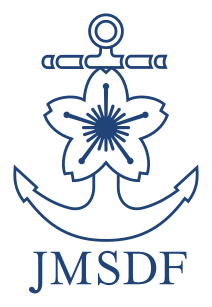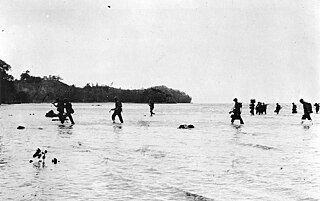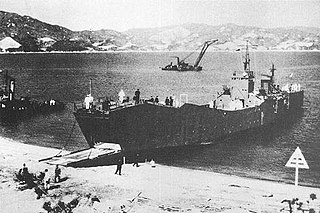Related Research Articles

A commando is a combatant, or operative of an elite light infantry or special operations force using dedicated operation techniques.

The Southern Expeditionary Army was an army group of the Imperial Japanese Army during World War II. It was responsible for all military operations in South East Asian and South West Pacific campaigns of World War II. Its military symbol was NA.

Hōshō was the world's first commissioned ship that was built as an aircraft carrier, and the first aircraft carrier of the Imperial Japanese Navy (IJN). Commissioned in 1922, the ship was used for testing carrier aircraft operations equipment, techniques, such as take-offs and landings, and carrier aircraft operational methods and tactics. The ship provided valuable lessons and experience for the IJN in early carrier air operations. Hōshō's superstructure and other obstructions to the flight deck were removed in 1924 on the advice of experienced aircrews.

The Special Naval Landing Forces (SNLF), were naval infantry units of the Imperial Japanese Navy (IJN) and were a part of the IJN Land Forces. They saw extensive service in the Second Sino-Japanese War and the Pacific theatre of World War II.

Keiji Shibazaki was a Rear Admiral in the Imperial Japanese Navy. He was the commander of the Japanese garrison on the island of Betio of the Tarawa atoll during World War II.

Imperial Japanese Navy Land Forces of World War II were ground combat units consisting of navy personnel organized for offensive operations and for the defense of Japanese naval facilities both overseas and in the Japanese home islands.

Tenryū (天龍) was the lead ship in the two-ship Tenryū class of light cruisers of the Imperial Japanese Navy. Tenryū was named after the Tenryū River in Nagano and Shizuoka prefectures.

Tatsuta (龍田) was the second ship in the two ship Tenryū class of light cruisers in the Imperial Japanese Navy (IJN). She was named after the Tatsuta River in Nara Prefecture, Japan.

The Japan Maritime Self-Defense Force, also simply known as the Japanese Navy, is the maritime warfare branch of the Japan Self-Defense Forces, tasked with the naval defense of Japan. The JMSDF was formed following the dissolution of the Imperial Japanese Navy (IJN) after World War II. The JMSDF has a fleet of 154 ships and 346 aircraft and consists of approximately 45,800 personnel. Its main tasks are to maintain control of the nation's sea lanes and to patrol territorial waters. It also participates in UN-led peacekeeping operations (PKOs) and Maritime Interdiction Operations (MIOs).
Suzuya (鈴谷) was the third of four vessels in the Mogami class of heavy cruisers in the Imperial Japanese Navy. She was named after the Suzuya river on Karafuto (Sakhalin).

Jintsū (神通) was the second vessel completed in the three-ship Sendai-class light cruiser in the Imperial Japanese Navy (IJN), named after the Jinzū River in the Gifu and Toyama prefectures of central Japan. She was active in World War II in various campaigns including the Japanese invasion of the Philippines, the Battle of the Java Sea, and Battle of Midway. On 13 July 1943 in the Battle of Kolombangara, she was discovered during a night attack by American ships and sunk in combat.

The Battle of Tulagi and Gavutu–Tanambogo was a land battle of the Pacific campaign of World War II, between the forces of the Imperial Japanese Navy and Allied ground forces. It took place from 7–9 August 1942 on the Solomon Islands, during the initial Allied landings in the Guadalcanal campaign.

The special Type 4 Launch Ka-Tsu was a Japanese amphibious landing craft of World War II. The first prototype was completed in late 1943 and trials were conducted off Kure in March 1944.
Kure Naval District was the second of four main administrative districts of the pre-war Imperial Japanese Navy. Its territory included the Inland Sea of Japan and the Pacific coasts of southern Honshū from Wakayama to Yamaguchi prefectures, eastern and northern Kyūshū and Shikoku.

Okinoshima (沖島) was a large minelayer of the Imperial Japanese Navy (IJN), which was in service during the early stages of World War II. She was named after the Okinoshima Island in the Sea of Japan. She was the largest purpose-built minelayer in the IJN and the first Japanese minelayer to be equipped with a reconnaissance seaplane.

The No.101-class landing ships were a class of amphibious assault ships of the Imperial Japanese Navy (IJN) and Imperial Japanese Army (IJA), serving during and after World War II. The No.101 class ships were powered by diesel engines, while the similar No.103-class landing ships were powered by a steam turbine engine. The IJN called them 2nd class transporter. The No.103 class included the IJA's SB craft variant. This article handles them collectively.

The No.1-class landing ship was a class of amphibious assault ships of the Imperial Japanese Navy (IJN), serving during and after World War II. The IJN also called them 1st class transporter.
The 5th Kure Special Naval Landing Force was a naval infantry battalion of the Imperial Japanese Navy's Special Naval Landing Forces.
The 2/21st Battalion was an infantry battalion of the Australian Army. Raised for service during Second World War as part of the Second Australian Imperial Force, it was formed on 11 July 1940 at Trawool in central Victoria as part of the 23rd Brigade of the 8th Division. It was subsequently deployed to Ambon as part of Gull Force in December 1941 following the Japanese invasion of Malaya; however, with the defence of the island considered untenable due to the limited military resources available and overwhelming Japanese strength it was subsequently captured despite determined resistance, surrendering on 3 February 1942. Most members of the battalion became prisoners of war, and a large number died in captivity.
Ro-26, originally named Submarine No. 45, was an Imperial Japanese Navy Kaichū-Type submarine, the lead unit of the Kaichū IV subclass. She was in commission from 1923 to 1938 and from 1939 to 1940.
References
| This World War II article is a stub. You can help Wikipedia by expanding it. |
| This article about the military of Japan is a stub. You can help Wikipedia by expanding it. |